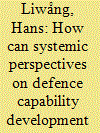| Srl | Item |
| 1 |
ID:
192605


|
|
|
|
|
| Summary/Abstract |
Over the last thirty years, suggestions for how to develop defence capability have developed rapidly. However, supporting theory and structured concept development lag behind. Despite this imbalance, countries need to continuously spend resources on defence development. This study identifies central challenges in relation to the scientific perspectives and approaches needed to support the development of defence capability. The results show that the support for developing interactions between technology and social components is especially weak and that relevant supporting theories and methods from related fields are not considered. This study also shows that it is important to be able to address these questions from various perspectives and not to be limited by a specific scientific tradition. Finally, this study also identifies a possible emerging cluster of reports on capability-related research that provide a base for a much-needed cross-disciplinary approach to the development of defence capability.
|
|
|
|
|
|
|
|
|
|
|
|
|
|
|
|
| 2 |
ID:
146624


|
|
|
|
|
| Summary/Abstract |
The anchoring effect is a well-studied subject. This article connects the effect with the rules-in-use within a military intelligence institution. Particularly the rules-in-use that dictate that an analyst takes his or hers starting point from recently conducted assessments of the specific area or threat. The threat assessment as well as the written assessment were affected. The results show that officers have an aversion to lower a previous given threat assessment. This gives that to understand risk assessment we not only need to understand the methods used, we also need to understand the institutions in which they are used. This is especially relevant for military intelligence as the assessments are conducted in an environment of high uncertainty.
|
|
|
|
|
|
|
|
|
|
|
|
|
|
|
|
| 3 |
ID:
151702


|
|
|
|
|
| Summary/Abstract |
Risk management is a decision-support process and a vital tool for military planning and decision-making. Today, several nations utilize risk-based approaches to analyze the level of security in military operations. There are both strengths and challenges in applying risk-based approaches to support military decisions. In this article, the challenges related to risk communication are investigated with the aim of describing how a military organization should train to create a good environment for effective risk communication. The analysis finds that it is important for the organization to define and consistently use a shared risk understanding. Such a shared risk understanding will need a systematic development process that focuses on the future decision makers’ and analysts’ education and training. To reach understanding, all involved parties must have the chance to identify the problem, reflect on its implications, test different solutions and develop a solution.
|
|
|
|
|
|
|
|
|
|
|
|
|
|
|
|